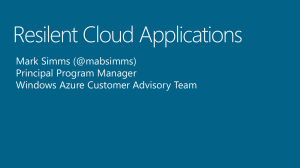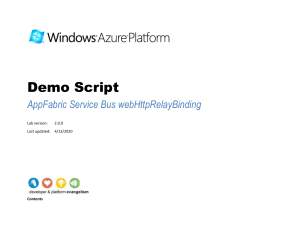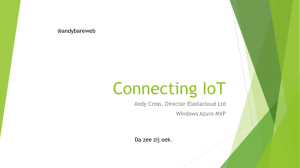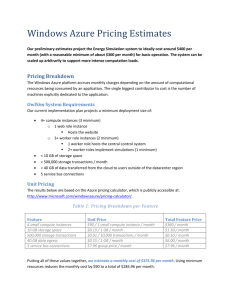Azure AppFabric Service Bus Enables Smart Grid Energy Savings
advertisement
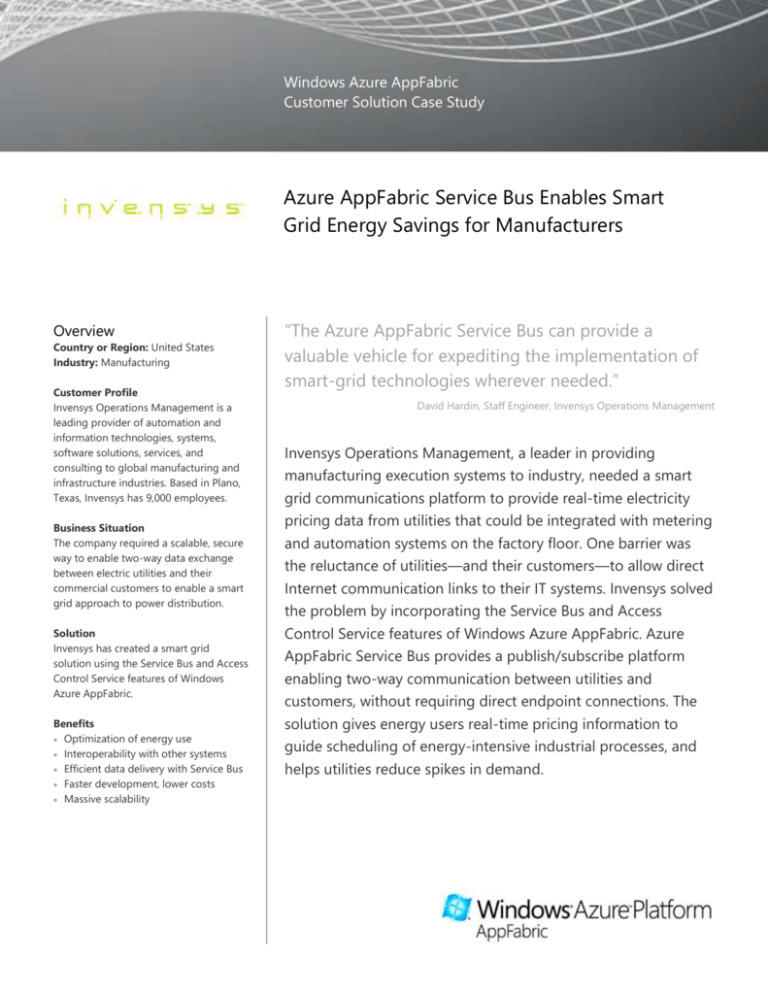
Windows Azure AppFabric Customer Solution Case Study Azure AppFabric Service Bus Enables Smart Grid Energy Savings for Manufacturers Overview Country or Region: United States Industry: Manufacturing Customer Profile Invensys Operations Management is a leading provider of automation and information technologies, systems, software solutions, services, and consulting to global manufacturing and infrastructure industries. Based in Plano, Texas, Invensys has 9,000 employees. Business Situation The company required a scalable, secure way to enable two-way data exchange between electric utilities and their commercial customers to enable a smart grid approach to power distribution. Solution Invensys has created a smart grid solution using the Service Bus and Access Control Service features of Windows Azure AppFabric. Benefits Optimization of energy use Interoperability with other systems Efficient data delivery with Service Bus Faster development, lower costs Massive scalability “The Azure AppFabric Service Bus can provide a valuable vehicle for expediting the implementation of smart-grid technologies wherever needed.” David Hardin, Staff Engineer, Invensys Operations Management Invensys Operations Management, a leader in providing manufacturing execution systems to industry, needed a smart grid communications platform to provide real-time electricity pricing data from utilities that could be integrated with metering and automation systems on the factory floor. One barrier was the reluctance of utilities—and their customers—to allow direct Internet communication links to their IT systems. Invensys solved the problem by incorporating the Service Bus and Access Control Service features of Windows Azure AppFabric. Azure AppFabric Service Bus provides a publish/subscribe platform enabling two-way communication between utilities and customers, without requiring direct endpoint connections. The solution gives energy users real-time pricing information to guide scheduling of energy-intensive industrial processes, and helps utilities reduce spikes in demand. “Within industrial settings we know there will soon be millions of devices . . . Depending on the flexibility of the manufacturing processes, devices can schedule themselves to operate during periods of lower-demand, and hence lower-cost electricity.” Paul Forney, System Architect, Invensys Operations Management Situation The once staid fields of electrical generation, distribution, and consumption have sprung to greater prominence in recent years with the advent of smart grids and smart meters to help all parties involved make better decisions about power usage. A smart grid refers to the digital technology being built into power distribution systems to provide massive data that can be used in a spectrum of ways to provide greater efficiency and reliability, as well as to support pricing models that encourage non-peak usage. Smart meters refer to a new generation of digital technology that give users real-time or near-real-time usage information, including—especially within industrial settings—detailed information on the quantity of power used, and the quality of power supplied. The combination of smart grids, smart meters, and related systems promises to open new potential for energy conservation around the world. Invensys Operations Management is a leading provider of automation and information technology, systems, software, computer-based hardware, and consulting for the global manufacturing and infrastructure industries. Headquartered in Plano, Texas, its solutions are used by more than 40,000 customers around the world with more than 200,000 plants and facilities. The company has approximately 9,000 employees and is a division of London-based Invensys, which makes industrial and railway control systems. Smart meter deployments around the world are measured in the tens of millions, and industry analysts predict the number will soar past 100 million within the next few years. While much of the adoption is driven by utilities upgrading residential meters to encourage conservation, industrial operations have also been quick to see the value of combining a smart grid with smart meters to reduce electrical usage and—by incorporating pricing data—reduce expenditures on electricity through scheduling use at non-peak times whenever possible. “Within industrial settings we know there will soon be millions of devices, as one plant could have dozens or hundreds of monitoring devices throughout their operations,” says Paul Forney, System Architect at Invensys Operations Management. “Each of these devices will need pricing information. That’s the beauty of what can be done with connecting smart devices with the smart grid. Depending on the flexibility of the manufacturing processes, devices can schedule themselves to operate during periods of lowerdemand, and hence lower-cost electricity.” Another benefit is that industrial operations, with the right pricing information, will be able to pick the best time to sell to the grid excess electricity they can produce from their own power generation facilities. The key to such solutions is the ability to freely exchange information. Invensys needed to create a smart grid communications platform, but faced the challenge of how to support the data exchange, especially with securityminded utilities—and their equally securityminded commercial customers—that are resistant to opening up Internet communication ports. Yet another challenge was helping smaller utilities overcome the hurdle of investing in the IT infrastructure typically associated with smart grid initiatives. The total power grid in the United States, and in most other places around the world, consists of a patchwork of electricity producers and distributors. With increasing interest in developing new energy sources, such as solar and wind, the number of grid participants is expected to increase. “Making smart grid a reality has required that utilities have a significant computational capacity to receive, calculate, and rebroadcast pricing data to the constituents,” says David Hardin, Staff Engineer at Invensys Operations Management. “We want to help utilities— and their customers—participate in a smart grid right away without having to wait years or making large capital investments.” Solution Smart Solution - Energy pricing information from the utility is combined with metering data within the manufacturing plant to facilitate the smart grid solution. Invensys has taken a step into the future by deploying a smart grid and smart metering solution in an industrial setting. Invensys is working with what it describes as a “very large manufacturing company with global operations” to deploy a pilot project. The first phase of the project, being deployed now, involves placing smart meters within one of the customer’s large manufacturing plants, and providing a smart grid solution to the electrical utility that supplies power to the plant. The Invensys solution delivers pricing information downstream from the utility to the manufacturing plant. Prices are automatically updated every time a price change occurs, which in unregulated power distribution markets can be as frequent as every 5 minutes or less. Price change information is consumed by Invensys metering equipment throughout the plant, which uses Invensys Wonderware manufacturing execution system (MES) software. The Invensys solution also measures variation in the quality of the power delivered, as spikes in power intensity can disrupt equipment or processes. Automated onsite monitoring enables a manufacturer to verify whether service level agreements (SLAs) with electric utilities have been met. A key component of the Invensys solution is its use of Windows Azure AppFabric Service Bus to enable an Internet-based neutral container to which utilities can publish pricing data, and to which customers can subscribe. This enables distribution of near-real-time pricing information without either party having to open their IT infrastructures to direct endpoint connectivity—a major relief to those charged with enforcing digital security. Azure AppFabric Access Control Service enforces user authentication. The solution stores pricing, MES data, and other information using Microsoft SQL Azure, a relational database for Internet-based, or cloud computing. The company sees use of the Windows Azure platform as greatly reducing the cost of entry for utilities and commercial customers seeking the benefits of smart “Our cloud-based solution uses the Service Bus feature and the Access Control Service feature of Azure AppFabric to enable utilities to publish pricing information onto a fabric that can be securely subscribed to by smart devices." Paul Forney, System Architect, Invensys Operations Management grid participation. Rather than having to build and manage dedicated data centers, organizations can simply subscribe to the cloud-based Invensys services. “There are a limited number of utilities, but hundreds of thousands of manufacturing plants that have huge energy bills each month and could benefit from using realtime pricing information to optimize their energy management,” says Forney. “Our cloud-based solution uses the Service Bus feature and the Access Control Service feature of Azure AppFabric to enable utilities to publish pricing information onto a fabric that can be securely subscribed to by smart devices. This frees industrial customers from having to expose endpoints for subscription callbacks which, for security purposes, most are reluctant to do.” Invensys works with the Open Access Same-Time Information System (OASIS), the National Institute of Standards and Technology (NIST), and other organizations to help guide development of a standardsbased smart grid. The service-oriented architecture (SOA) cloud-based solution Invensys is deploying in its pilot project contains a number of design elements, including: Service Bus. Invensys uses the Service Bus feature of Windows Azure AppFabric to provide a neutral messaging relay space to enable connectivity across trust boundaries. The Azure AppFabric Service Bus makes it easy to connect applications over the Internet. Services that register on the Service Bus can easily be discovered and accessed across virtually any network topology. “The Azure AppFabric Service Bus solves some very important problems,” Hardin says. “Usually with a notification technology, you have to worry about getting around inbound ports that are guarded by firewalls. Also, for some IP addresses, you have to use network address translation stations to get to devices. These barriers make it difficult to send messages from one machine to another. The Service Bus solved these problems for us because we can send messages without worrying about closed inbound ports.” Access Control. Invensys uses the Access Control Service feature of Windows Azure AppFabric to extend identity information to users of the Service Bus. The Azure AppFabric Access Control Service provides authorization services for applications connecting over the Internet. It provides an easy way to control Web applications and services while integrating with standards-based identity providers. Authorization decisions can be pulled out of the application and placed in a set of rules that can transform incoming security claims into claims that applications understand. Publish and subscribe. Invensys uses the Windows Communication Foundation (WCF) to support the publish and subscribe model within the Service Bus. WCF supports publish and subscribe connectivity through a directory structure based on URLs. This technology, coupled with Azure AppFabric Access Control Service, provides a scalable infrastructure that can technically support the secure delivery of dynamic pricing information, down to five-minute pricing updates, from the wholesale markets to manufacturers and other consumers on a massive scale. Application server. The Invensys application server receives continually updated pricing information from the utility as well as data from Invensys Wonderware System Platform which “The Azure AppFabric Service Bus and Access Control Service are features that we feel are unmatched in other cloud offerings.” David Hardin, Staff Engineer, Invensys Operations Management provides real-time operations management software to enable customers to synchronize their production operations with business objectives. Plant engineers can work directly with the Invensys application server from the dashboard interface of the application, using pricing information, for example, to schedule energy-intensive operations. The SOA design also supports programmatic control so tasks can be self-scheduling, depending upon electricity pricing and other criteria. For plants with supplemental power generation capabilities, the application can schedule the optimum times for selling electricity back to the grid. The application tracks when processes were run, applies the electrical rates that were in force, and gives an exact energy cost. Cloud database. Organizations not wanting to manage their database locally can use a cloud-based data store using SQL Azure, part of the Windows Azure platform that provides a full relational database. SQL Azure can also be used as an aggregation point for organizations with multiple facilities that store data onsite. Information from local databases can be brought together in the cloud to enable enterprise-wide analytics. The large manufacturer Invensys is working with for the current project will transfer on-premises data to the SQL Azure database which supports a dashboard for plant engineers and others interacting with the information. Local database. The Invensys design includes the option for organizations to store data on premises using Microsoft SQL Server 2008 R2 Enterprise database software running on the Windows Server 2008 R2 Enterprise operating system, in addition to using SQL Azure. Locally stored data can be analyzed for historical and trending information to gain insights into reducing electricity needs for different manufacturing operations. Dashboard interface. Invensys used the Microsoft Silverlight browser plug-in to create a graphical user interface for interacting with its smart grid application. The combination of the Azure AppFabric Service Bus and Access Control Service proved to be a winning combination as Invensys explored its options for developing and deploying its smart grid solution. “We evaluated Amazon EC2 and Google cloud products, but no one had anything comparable to the Azure AppFabric Service Bus,” Hardin says. “The Service Bus has the functionality, interoperability, and scalability required to provide a communications infrastructure that can be used for large-scale smart grid applications. The Azure AppFabric Service Bus and Access Control Service are features that we feel are unmatched in other cloud offerings.” Benefits The smart grid communications platform Invensys was able to create using Azure AppFabric technology will enable its industrial customers to achieve optimization of energy use, and interoperability with other systems, while benefiting from efficient data delivery. Invensys has enjoyed faster development and lower costs by incorporating Azure AppFabric into its design, while its customers benefit from the massive scalability the solution provides. Optimization of Energy Use Invensys sees the Service Bus and Access Control Service features of Windows Azure AppFabric as significant tools in helping its customers realize the smart-grid promise of optimizing energy use. Combining Invensys Wonderware monitoring information with “The general movement of the price of energy seems to be upward, and the higher the costs go, the bigger the rewards will be from optimizing energy use." Bill Schiel, Industry Solution Manager, Invensys Operations Management smart grid pricing data through the Azure AppFabric Service Bus will help customers reduce their energy costs by giving them the information required to better plan when to launch energy-intensive processes. The solution also provides savings by flagging the best times to reduce electrical use (sometimes referred to as energy shedding), and identifying the optimal times to sell back into the grid any excess energy a plant creates on its own from a co-generation infrastructure including diesel power plants, solar power, wind generation, or other sources. “We think this is a very important market to be in,” says Bill Schiel, Industry Solution Manager at Invensys. “The general movement of the price of energy seems to be upward, and the higher the costs go, the bigger the rewards will be from optimizing energy use. Some plants have a relatively constant energy demand, but in many cases there is sufficient flexibility to schedule energy-intensive operations for low-demand, and hence, lower-cost, hours. With some operations spending $1 million or more a month for electric power, even a 3 percent savings through optimization adds up.” As more organizations create their own power generation solutions, there will be increased interest in determining the optimal time to sell electricity back into the grid. “Many operations already have backup generators,” Forney says. “And if an operation has warehouses covering acres of ground, with solar panels on the roofs, they may want to maximize the value of the power they sell into the grid by day and move as much of their energy-intensive operations as possible to the night.” Interoperability with Other Systems Invensys sees the benefits of its smart grid solution being magnified the more deeply an organization integrates the information with its other operations, including the MES solutions that Invensys develops and deploys using the Microsoft Application Platform, and enterprise resource planning (ERP) solutions that customers have in place. Of course, manufacturers can’t schedule operations solely on the basis of the cost of energy, as they need to satisfy orders, deal with backlogs, maintain inventory, and respond to other real-world pressures. But combining smart-grid data with ERP ordering information, and linking this with manufacturing execution systems could enable a deeper degree of interoperability that could result in lower energy costs while retaining optimal productivity. “The ERP system dictates when a manufacturer needs to build automatic transmissions, for example, to fill an order,” Forney says. “Incorporating costing information from the utility can enable the manufacturing execution systems to schedule something like the energydemanding extrusion process to be accomplished during hours when energy was at a lower cost.” The same kind of interoperability could enable a system to delay the beginning of a complex manufacturing process if information from the smart grid indicated that demand was so high that a brown-out could occur, which could interrupt the process, causing the loss of all the raw materials. “If someone makes an error and runs a big process that's energy intensive at the wrong time, they could basically kill the profit they were going to be making on that product run,” Forney says. “This sort of energy management—tied to dynamic pricing information that we're getting from “We are using Azure AppFabric to create realworld solutions for today, and we are using the same tools to create the energy solutions that will be needed in the future.” Bill Schiel, Industry Solution Manager, Invensys Operations Management the independent system operators, as well as qualitative information on anticipated power supplies—combined with needs from MES and ERP systems, could have a big impact. Imagine if every plant had 500 meters monitoring all different aspects of a process and each of these meters had connectivity to Azure AppFabric to pull down their pricing information and do their calculations and then send the information over to their SQL Azure databases. Invensys already makes intelligent manufacturing execution systems. Adding smart-grid information and ERP data will make them even more intelligent.” Looking ahead, Schiel notes, “We are using Azure AppFabric to create real-world solutions for today, and we are using the same tools to create the energy solutions that will be needed in the future.” Efficient Data Delivery with Service Bus The Azure AppFabric Service Bus proved to be exactly the solution that Invensys needed because it enables data transfer without having to expose endpoints on either the utility’s side or the manufacturer’s side. The solution also enables smaller utilities to immediately deploy smart-grid solutions without having to invest in the creation and management of data centers. “Utilities and their industrial customers all have stringent IT security measures in place,” Forney says. “Whether it is a nuclear-powered utility on one side or a chemical plant on the other, no one wants to expose endpoints to enable services to cross the firewall. A virtual private network (VPN) couldn’t really replace what the Azure AppFabric Service Bus does because a VPN opens a network to everything on the other end of the tunnel. Another alternative would be pinging an outgoing response service, but if that one endpoint is being pinged by millions of devices, you run into scalability problems in a hurry. The enhanced security provided by our approach to deployment is one of the reasons the Azure AppFabric Service Bus is so important to us.” The efficiency of the Azure AppFabric Service Bus could help open the doors to smart grid solutions throughout the industry. “The Azure AppFabric Service Bus can provide a valuable vehicle for expediting the implementation of smartgrid technologies wherever needed,” Hardin says. “It can be accessed widely and securely, paid for as used, and expanded as needed. It provides the security, interoperability, and performance required for large-scale smart grid applications, at a significantly lower cost than building data centers.” Faster Development, Lower Costs Invensys says that using the Azure AppFabric Service Bus and Access Control Service not only lowered its development costs, but made the solution possible in the first place. “Without the Azure AppFabric Service Bus, we might not even have tackled this project,” Hardin says. “Building an Internet-based service bus with this capability and performance would have been a monumental development challenge and expense costing hundreds of thousands of dollars.” Massive Scalability Using the Azure AppFabric Service Bus as their communications highway, utilities using the Invensys solution can easily scale their smart grid infrastructure to keep pace with need. “The Service Bus has massive scalability at very reasonable costs and can elastically scale up or down as need demands,” Hardin says. “There’s no physical on-premises infrastructure to deploy or depreciate, and a utility can bump up "We benefit from the fact that, because our solution incorporates Azure AppFabric and other parts of the Azure platform, Microsoft is the one responsible for keeping the services up and running, secure, upto-date, scalable, and available." Paul Forney, System Architect, Invensys Operations Management capacity on demand, paying only for the communications traffic that they use.” The company sees scalability—and reliability—benefits in the fact that Microsoft hosts the Windows Azure platform that supports Azure AppFabric and SQL Azure. “We require the scalability and reliability to supply information to an ever-growing number of subscribers,” Forney says. “We need scalability, robustness, and the ability to offer whatever SLAs might be required. We benefit from the fact that, because our solution incorporates Azure AppFabric and other parts of the Azure platform, Microsoft is the one responsible for keeping the services up and running, secure, up-todate, scalable, and available. That’s a whole lot of data center responsibility that we don’t have to worry about.” Summary In summary, Invensys was able to create the smart-grid communications platform it needed, including the solution for securely exchanging data between utilities and commercial customers, by building its solution using the Service Bus and Access Control Service features of Azure AppFabric. For More Information Windows Azure AppFabric For more information about Microsoft products and services, call the Microsoft Sales Information Center at (800) 4269400. In Canada, call the Microsoft Canada Information Centre at (877) 5682495. Customers in the United States and Canada who are deaf or hard-of-hearing can reach Microsoft text telephone (TTY/TDD) services at (800) 892-5234. Outside the 50 United States and Canada, please contact your local Microsoft subsidiary. To access information using the World Wide Web, go to: www.microsoft.com Windows Azure AppFabric is a set of application services focused on improving the performance and management of cloud-based applications. To deliver these benefits, Windows Azure AppFabric provides AppFabric Service Bus to provide a neutral messaging relay space to enable connectivity across trust boundaries, and Access Control Service to extend identity information to users of the Service Bus. For more information about Windows Azure AppFabric, please visit: www.microsoft.com/windowsazure/appfabr ic/ For more information about Invensys Operations Management products and services, visit the Web site at: www.invensys.com Software and Services Windows Azure Platform − Windows Azure AppFabric − SQL Azure Microsoft Server Product Portfolio − Microsoft SQL Server 2008 R2 Enterprise − Windows Server 2008 R2 Enterprise Hardware This case study is for informational purposes only. MICROSOFT MAKES NO WARRANTIES, EXPRESS OR IMPLIED, IN THIS SUMMARY. Document published May 2010 Technologies − Microsoft Silverlight for Windows − Windows Communication Foundation Varies by customer



